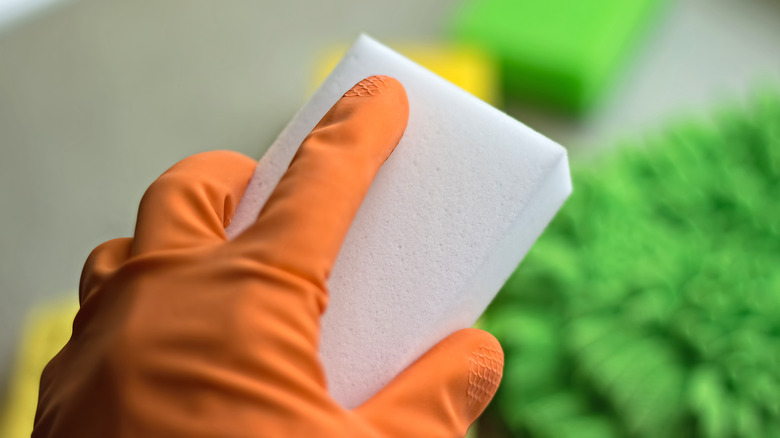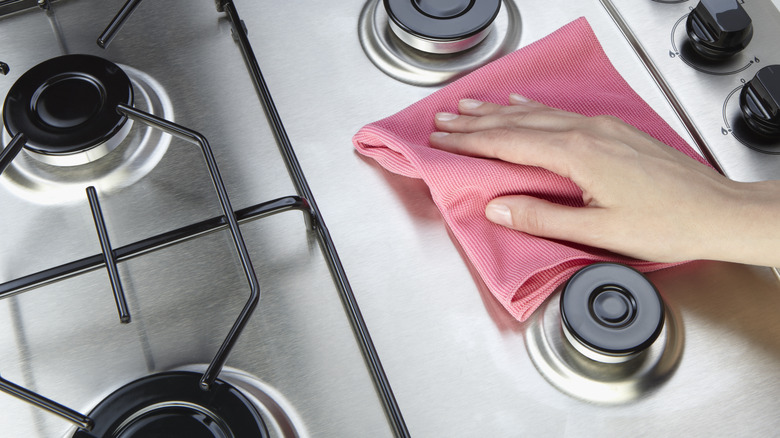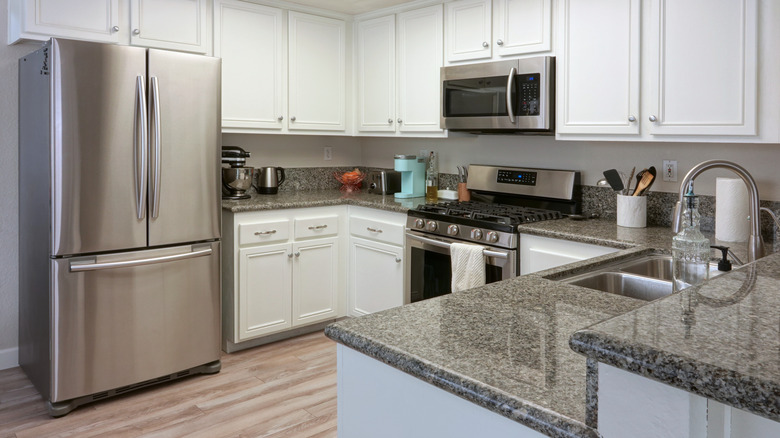The Finish Commonly Found In A Kitchen That Can Be Dulled By A Magic Eraser
A commonly used cleaning tool in the kitchen is the melamine sponge, better known as a magic eraser. This handy scrubber, made of melamine foam, is known for its versatility in removing tough stains. However, there's one popular kitchen finish that's not compatible with the magic eraser, and that's stainless steel. Although stainless steel adds a sleek and shiny look to kitchen spaces, it's easily damaged (and dulled) if not properly cared for.
The truth about magic erasers is that they remove dirt, grime, and stains — even those pesky permanent marker stains — with their slightly abrasive surface created by microscopic crystals that create friction. But this microabrasion can create tiny scratches on stainless steel, which when accumulated over time result in a dulling effect, diminishing the shine and luster of the material. Suddenly, what used to be a lustrous kitchen appliance or countertop is now minus its sparkle, ending up looking pretty lackluster.
Achieving sparkling stainless steel
To clean stainless steel surfaces in your kitchen, the keyword is "soft." Rather than use a magic eraser, which can dull stainless steel finishes over time, you'll want to opt for a soft cloth or sponge instead, along with warm water and mild dish soap. After the initial cleaning, use a microfiber cloth to dry and polish the surface. Microfiber cloths are nonabrasive and highly effective in removing streaks and smudges on various surfaces without causing scratches. For fingerprints, you can use a stainless steel polish or even glass cleaner.
To remove tough stains or mineral deposits, mix equal parts water and white vinegar in a spray bottle. Spray onto the area, let sit for a few minutes, and wipe clean with a soft cloth. Rinse thoroughly with water. For stubborn stains or grease buildup, apply a paste made of baking soda and water to the affected areas, again with a soft cloth or a sponge. Gently rub in circular motions, rinse well with water, and dry with a microfiber cloth. To maintain the shine of your stainless steel, wipe up spills promptly and avoid abrasive pads, like a magic eraser, or harsh chemicals.
Tips for a gleaming kitchen
Beyond dulling stainless steel appliances and/or countertops, a magic eraser, with its microabrasion, can damage other materials in a kitchen as well. For instance, you should avoid using magic erasers on nonstick cookware, as they can scratch up a pot or pan's coating. Delicate surfaces like marble or granite countertops, meanwhile, also require special care. Instead of scrubbing them with a melamine sponge, opt for a nonabrasive cleaner, one formulated expressly for stone.
As for your stainless steel, if there are scratches, depending on how deep they are, you could repair the finish with some common household products, like toothpaste. Toothpaste, used in combination with a microfiber cloth, can buff out small scratches (such as those created by a magic eraser). If you don't have microfiber cloths on hand, soft cotton cloths or even clean, lint-free T-shirts can work, too. Also, wiping in the direction of the metal's natural grain while cleaning can make a noticeable difference in achieving or restoring a lost sheen.


